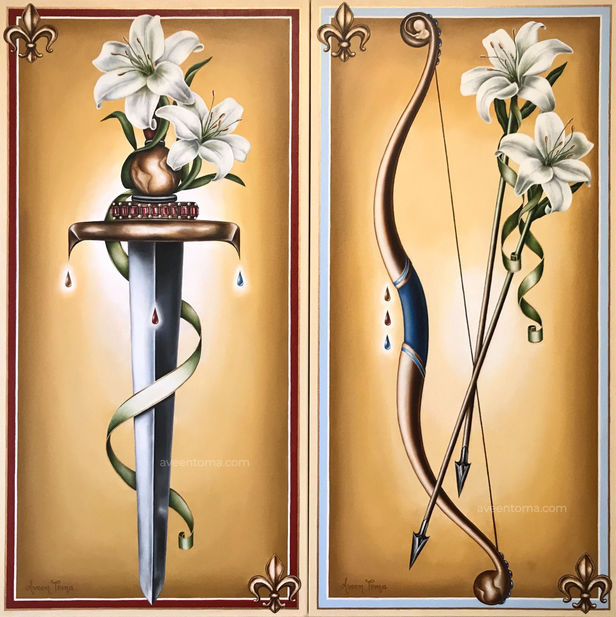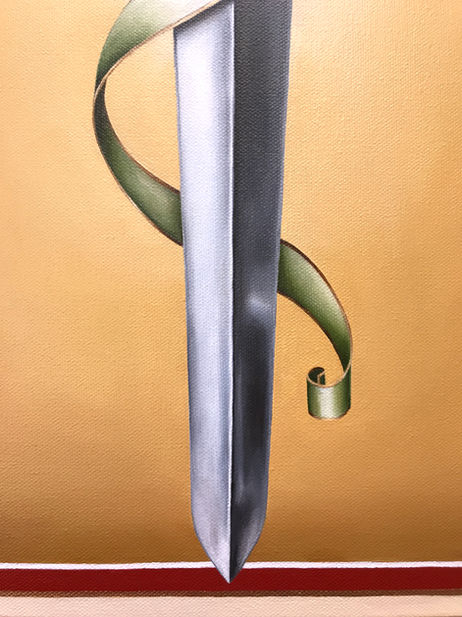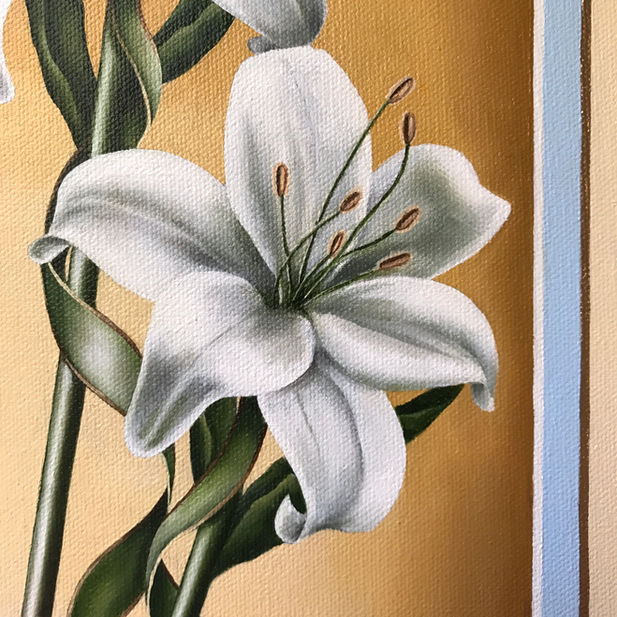Terror of Demons & Protectress of Humanity
Diptych
oil & liquid gold leaf on canvas
30 x 15 in (each)
2020
not for sale
With the ever-rising crisis in the world of true fatherhood and motherhood, and the growing confusion of what masculinity and femininity inherently entail, the respective roles of men and women have become distorted and, in turn, the beauty and wholeness of the family has been stripped. Men and women are being attacked and becoming confused about their respective, irreplaceable roles, which is gradually depriving the basic unit of society of any truth, goodness, or beauty, and making it ever more challenging for the family to attain holiness. Yet, the world is a battlefield, and each mother and father is given different, though complementary, weapons to fight in the same battle— working together to protect and preserve the family. Conveniently, we have two perfect exemplars of true fatherhood and motherhood to look up to and to help us see the innate beauty and power in the role of men and women.
The left painting of this diptych, Terror of Demons, is based on St. Joseph and represents true fatherhood and masculinity— as St. Joseph is the epitome of what it means to be a father. A sword is chosen for fatherhood because such a weapon is used in direct combat in battle; in the same way, the role of a father is to be on the “frontlines” in the battle waged against the family, active in combat and willing to lay down his life for his wife and children. At the same time, the sword illustrates St. Joseph’s “Sword of Purity,” which every man is called to wield against the attacks of the Enemy. A regal, commanding, yet delicate sword is illustrated, with prominent lilies encircling the hilt. The white lilies represent innocence and purity of heart, mind, body, and soul (that is, purity in feelings and motives, in thoughts, in behavior and speech, and in the spiritual life). At the base of the sword’s grip is a golden globe, which symbolizes how the world is not only in dire need of more virtuous men like St. Joseph, but how the world is also grounded upon such men. At the base of the hilt is a row of red gemstones and pearls, which add to the elegant and royal nature of the sword as St. Joseph is of the royal line of King David. The stems of the lilies transform into a ribbon which encircles the blade. While this movement adds to the royal nature of the weapon, the ribbon also alludes to the biblical image of the serpent-entwined rod: the traditional medical symbol representing healing. In this way, the father should be a source of healing and comfort to all those entrusted to his care who look upon him in times of need. Finally, the red, gold, and blue droplets symbolize blood, sweat, and tears, respectively, as the role of a father inherently entails sacrifice (blood), hard work (sweat), and joyous and sorrowful emotions (tears).
The right painting of this diptych, Protectress of Humanity, is based on the Virgin Mary, Our Blessed Mother, and represents true motherhood and femininity— as Mary is the epitome of what it means to be a mother. A bow and arrows are chosen for motherhood because such a weapon is used indirectly in battle, from afar; in the same way, the role of a mother is to participate in the battle waged against the family in such a way as to assist and direct the father. From a higher plain, the mother is able to stand guard and both attack and watch for approaching enemies in the distance, and so help direct the husband who is on the frontline. An elegant and regal bow is illustrated with lilies that transform into arrows. At the top of the bow is an image of a fetus, as mothers are the ones privileged to bear life into the world and are called to protect humanity from its very conception. At the bottom of the bow is a golden globe, which likewise symbolizes how the world is in desperate need of more women who reflect Mary, especially as it pertains to protecting life, but also how the world is built on the way in which a mother raises her family. Along the rim of the bow are a total of twelve blue gemstones, which both add to the elegant nature of the weapon and allude to the twelve stars that traditionally crown Mary. Prominent white lilies are also illustrated, which again represent innocence and purity of heart, mind, body, and soul. It is the power of such purity that transforms into the means by which she attacks the Enemy— truly virtue is as a sharpened blade in the face of vice. Likewise, the stems of the lilies transform into ribbons, which can also be seen as a motif of healing and comfort. Again, the red, gold, and blue droplets are illustrated, as the role of a mother also inherently entails sacrifice, work of a different kind, and joyous and sorrowful emotions.
The design of the two paintings are based on the design of the king and queen playing cards, which not only gives each piece a relatable quality, but also underscores the royal value found in possessing these “cards” in one’s hand. Instead of the traditional playing card suits, these pieces belong to the “Fleur de Lis” suit (this symbol simply represents a stylized lily). In this way, these pieces become the “King of Fleur de Lis” and the “Queen of Fleur de Lis.” The border of Terror of Demons is a deep red, which evokes a more masculine, commanding emotion, while the border of Protectress of Humanity is a light blue, which evokes a more feminine, gentle emotion and is the color most associated with the Virgin Mary. Ultimately, each man, husband, and father is called to be a “Terror of Demons” (an official title of St. Joseph), and each woman, wife, and mother is called to be a “Protectress of Humanity” (a personal, imaginary title I created for Mary)— and so, together, this diptych symbolizes the Holy Family. Only when the mother and father fight together, with the love and acceptance of their distinctive, complementary roles— and listen to one another’s directives— can they effectively protect the family and help lead one another and their children to Heaven.












